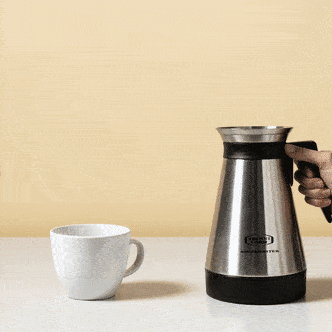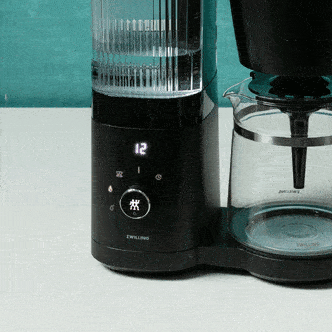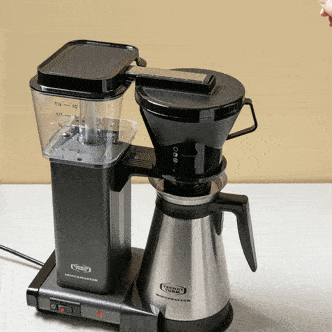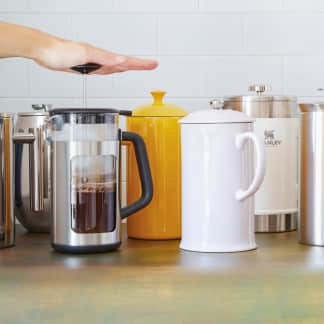We tested automatic drip coffee makers at prices ranging from less than $20 to nearly $375, seeking models that brewed flavorful, hot coffee and were easy to use. Our favorite is the Technivorm Moccamaster KBT. Its powerful copper boiler quickly heats and holds water at a precise temperature for coffee that tasters described as “very strong but smooth.” Besides its single on/off control and clean design, we also loved its five-year warranty and its easily replaceable exterior parts, which ensure a long, useful life. We also recommend the OXO Brew 8-Cup Coffee Maker for the good coffee it makes as well as its compact profile, intuitive controls, and the most ergonomically pleasing carafe we’ve seen in years of testing. Our Best Buy is another compact model: the Zojirushi ZUTTO Coffee Maker. While we’re not fans of its glass carafe, it brewed very good coffee. We loved its removable water tank, simple controls, and easy cleanup.

If you love drip coffee, you know how disappointing many automatic drip coffee makers turn out to be—all promise and no delivery, making coffee that’s weak, sour, acrid or bitter, or not hot enough. Add in complicated controls, drippy carafes, and hard-to-fill water tanks, and they also can be frustrating to use.



Our tasters sampled coffee brewed in each machine (left). We saw different flavors and bodies among coffee samples in the tasting (right), even though they were brewed with the same coffee grounds and water. Samples were randomized and assigned three-digit codes to prevent bias.
In our testing, we were astonished by how different coffee makers could make the same two ingredients—identically prepared ground coffee and water—taste wonderful or terrible. We looked high and low for a machine that would produce delicious, perfectly brewed, piping hot coffee every time with minimal fuss. We started by choosing from a list of home coffee makers certified as good performers by the Specialty Coffee Association (SCA), a coffee-industry group focused on improving coffee quality through education and scientific standards, and rounded out our lineup with promising models that were not on their list, giving us machines with a wide range of prices—from less than $20 to nearly $375. Here’s what we learned after brewing, testing, and drinking gallons of coffee.
What to Look For
- Great Flavor: Your coffee maker should make coffee you’ll actually enjoy drinking. Coffee makers may have a similar look and seem like a fairly basic piece of equipment, but subtle differences can change whether or not they hit certain benchmarks for heating, timing, and water/coffee contact in order to produce good coffee. Great coffee is an alchemy of these factors (plus quality coffee beans and good-tasting water). When a machine met them all, we recommended it.
- Simple, Intuitive Controls: Anyone should be able to operate the coffee maker with little effort. Don’t laugh; a couple of these machines were ridiculously complex, with a steep learning curve. We preferred pared-down designs with intuitive switches, markings, and/or displays.
- Correct-Size Brewing Basket: Brewing baskets must be big enough to hold plenty of ground coffee for a suitable coffee-to-water ratio. Not all machines could hold the 55 grams of coffee needed to meet the SCA standard for 1 liter of water. Several had 64-ounce (1.8-liter) water tanks paired with fairly petite brewing baskets, which sometimes overflowed when we made a full pot of coffee using the SCA ratio. If we reduced the grounds, the coffee was weak. In short, huge water tanks should be matched by roomy brewing baskets.


To make good coffee, you need the right ratio of coffee grounds to water, which SCA defines as 55 grams of coffee per 1 liter of water. Some coffee makers we tested have too-small brewing baskets that don't match their large water tanks. The brewing basket on the left was adequately sized to hold the right proportion of coffee when brewing a full pot. Coffee overflowed in the basket on the left, which was too small.
- Right Speed and Temperature: Good automatic drip coffee comes from water heated to between 194 and 205 degrees Fahrenheit that spends between 4 and 8 minutes in contact with the grounds during the brewing cycle. Our top models hit these industry-standard SCA benchmarks for extracting great flavor. (Note: SCA recently adjusted this temperature range recommendation in light of new research, according to SCA Certifications Programs Manager Jessica Rodriguez. The longtime standard was 195 to 205 degrees Fahrenheit.)

- Thermal Carafe: Keeping fresh coffee hot without scorching it is easiest when the machine brews into an insulated thermal carafe. We also prefer sturdy stainless-steel thermal carafes to glass carafes, as glass can shatter (forcing you to locate and buy a replacement).
- Clear, Accurate Instructions: A manual should clearly spell out how to operate the machine and how much coffee you should use for different volumes of water. (Machines that recommended using SCA’s widely accepted science-based coffee-to-water ratios earned bonus points.)

- Easy to Clean: Removing filters with spent coffee grounds should be a simple and neat process. We also liked carafes that were easy to scrub, with well-designed lids that didn’t trap water.
- Neat, Comfortable Pouring: Carafes should be comfortable to hold and easy to control for accurate pouring without splashing or dribbling.


Some carafes, such as that of our winner on the left, poured neatly and comfortably; others, such as the one on the right, dribbled and splashed coffee and splayed our hands awkwardly, as we had to push levers and buttons while pouring.
- Visible Water Tank Fill Lines: Water fill line indicators should be easy to read. Bailing water out of an overfilled reservoir is a pain. We appreciated models with removable water tanks.
What to Avoid
- Fussy, Confusing Controls: You shouldn’t have to constantly consult the manual to figure out how to operate a coffee maker. The learning curve of some machines was too steep, requiring users to master puzzling symbols and special sequences for dialing and pushing various buttons—just to make a basic pot of coffee.


Making coffee should be easy. We preferred machines with a simple on/off switch (right) to machines with multiple dials, lights, symbols, and buttons (left).
- Undersized Brewing Baskets: One machine consistently overflowed when we used the correct SCA coffee-to-water ratio for a full pot, and a few others nearly overflowed. Their manuals suggested less than half the correct quantity of grounds needed to brew great coffee, given the size of their water reservoirs.

- Messy Brewing Baskets: Cleaning out coffee grounds and residue after brewing shouldn’t be hard or make a mess. We liked handles or other designs that helped us grab the brewing basket and neatly dump disposable filters or empty permanent ones.


We liked machines that made it easy and neat to clean up. With the coffee maker on the left, we found it messy (and hot) to grab the brewing basket. On the right, a handle on our winner's basket was simple to grasp and made it easy to dump out the spent grounds without touching them.
- Vague (or Missing) Instructions for How Much Coffee to Add: We get that the amount of grounds each user chooses will vary according to taste, but manufacturers should provide guidelines that make sense. Some omitted this crucial information from their manuals.
- Drippy Carafes: A few of the carafes either dribbled or gushed coffee as we poured. Some were very heavy when full and made us hold down a tab on top of the handle while pouring, which was awkward. Others had lids that were tricky to put on. Worse, a few lids routinely trapped tablespoonsful of dishwater that drained out days later. Yuck.
- Glass Carafes with Heating Plates: Most coffee machines with glass carafes use the same element to heat the water and the hot plate—a recipe for scorched, bitter coffee. A few models had separate, gentler heaters and an automatic shutoff for the plate. We still found these problematic: They slightly overheated coffee before letting it go cold. If you typically don’t drink all your coffee right away, go for a thermal carafe. Plus, if you can’t find an affordable replacement for a broken glass carafe, the whole machine goes to the landfill.
Other Considerations
- “Strong” or “Bold” Settings: When machines offer this option, don’t choose it. It just makes the brewing cycle last longer, which results in overextracted grounds and bitter coffee.

- Coffee Scoops: Ground coffees have radically different weights and volumes depending on how they are roasted and how finely or coarsely they’re ground. Most machines came with coffee scoops, but these were misleading and useless. If you want good coffee, buy a scale and weigh your grounds.
The Tests:
- Brew multiple full pots of coffee in each coffee maker
- Measure the capacity of each machine’s brewing basket and water tank to confirm they can hold enough coffee and water to brew a full pot at the proper ratio of water to coffee
- In a randomized tasting, have a panel of tasters sample and rate the flavor and body of the coffee brewed in each machine. Samples were randomized and assigned three-digit codes to prevent bias
- Note the brewing water temperature and brewing cycle duration; calculate the percentage of the cycle spent in the ideal extraction temperature range of 194 to 205 degrees Fahrenheit
- Have an independent laboratory, Coffee Enterprises of Burlington, Vermont, test randomly numbered samples of coffee brewed in each coffee maker to measure total dissolved solids (desired range is 1.15 to 1.55 percent) and calculate percentage extraction (desired range is 18 to 22 percent), which refers to the amount of compounds in the coffee that have been extracted into the water. Both readings are indicators of a machine’s ability to brew at the optimal concentration and strength
- Check the temperature of brewed coffee in the carafes (on their hot plates, where applicable) when freshly brewed, 1 hour later, and 2 hours later
- Evaluate other special features of individual coffee makers, if applicable
How We Rated:
- Coffee Quality: We assessed the machines’ ability to meet industry standards for excellent coffee (including factors such as temperature, time, and water-to-coffee ratio) and rated the brewed coffees in a randomized tasting.
- Ease of Use: We noted whether the machines were easy, intuitive, and comfortable to handle and operate.
- Carafe: We rated the designs of the carafes, noting how comfortable they were to hold while pouring and how well they poured, and measured their heat retention in both thermal carafes and glass carafes on hot plates.
- Cleanup: We noted whether it was easy to keep machines and carafes clean, intact, and in good working order.
































